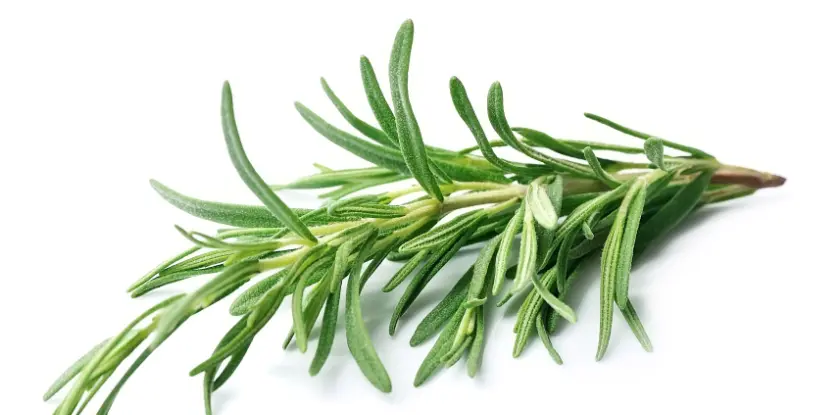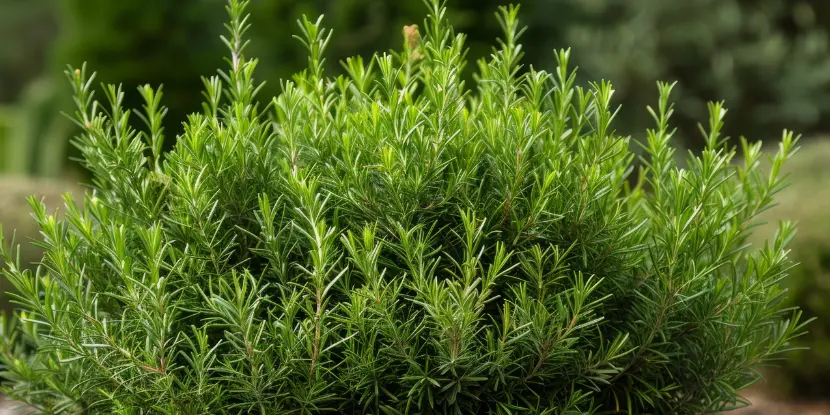Rosemary is native to the Mediterranean region. Its name comes from the Latin words ros (dew) and marinus (sea), meaning “dew of the sea.” Ancient Greeks and Romans considered rosemary a symbol of remembrance, love, and fidelity.
In the kitchen, it’s an essential seasoning for stuffing, roasted potatoes, focaccia, braised vegetables, and more. In the garden, it’s an attractive and fragrant evergreen shrub that makes a superb ground cover in mild climates.
Despite its needle-like leaves and pine-like aroma, rosemary belongs to the mint family, which includes sage, mint, and basil. Once established, it needs very little care.
‘Tuscan Blue’ and ‘Blue Spires’ are excellent cooking varieties due to their strong flavor and aromatic oils.

Rosemary leaves are an essential ingredient in stuffing, roasted veggies, and more.
Ideal Conditions for Rosemary
Sunlight
- Rosemary is a sun-loving plant that requires at least 6–8 hours of direct sunlight daily.
- It tolerates some shade, but the leaves may lose flavor, and the plant may become leggy.
- Choose a spot in your garden that receives full sun for optimal growth and flavor.
Soil
- Rosemary prefers well-drained, sandy soil with a pH of 6.0 to 7.0.
- If you have heavy clay soil, amend it with sand and compost to improve drainage.
- Avoid planting rosemary in areas with soggy soil.
Temperature
- Rosemary prefers temperatures between 60–80°F (15–27°C).
- It’s hardy in USDA zones 8–10, where winters are mild.
- Prolonged exposure to temperatures below 30°F (-1°C) can damage or kill the plant.
- If you live in a region with harsh winters, protect outdoor rosemary with a frost cloth or mulch, or grow it in pots to move indoors when needed.
- Indoors, ensure the plant has adequate sunlight and avoid placing it near heating vents or drafty windows.
Planting Rosemary
Seeds or Cuttings?
- Rosemary seeds are challenging to germinate and have a low success rate.
- It’s best to start with cuttings from an established plant.
Starting from Cuttings
- Take a healthy 4-6 inch stem cutting from an established rosemary plant.
- Remove the leaves from the lower half of the cutting.
- Dip the cut end into rooting hormone (optional) for faster growth.
- Plant the cutting in moist potting soil or a jar of water until roots develop (1-2 weeks).
- Transfer to the garden or a larger pot once roots are established.

It’s possible to grow rosemary from sprigs, if they’re fresh enough.
When to Plant
- If starting from cuttings, plant them in spring after the last frost.
- You can also plant in early fall when temperatures are cooler and the soil is moist.
Preparing the Soil
- Dig a small hole, fill it with water, and check how long it drains. If the water pools for over half an hour, amend the soil with sand or perlite to improve drainage.
- Mix in compost to boost nutrients without overcompensating for rosemary’s preference for moderately lean soil.
- Ensure the soil bed is smooth and level.
Steps for Planting
Outdoor Planting
- Make a hole twice as wide and as deep as the plant’s root ball.
- Place the root ball in the hole and backfill it with soil. The plant’s crown should be level with the surface.
- Give the plant a good soak to help the roots settle into the soil. Then, allow the top layer of soil to dry out before watering again.

Rosemary makes an excellent ground cover plant.
Indoor Planting
- Choose a container with drainage holes.
- Fill the pot with well-draining potting soil.
- Plant the rosemary so the crown is level with the soil line.
- Place it in a spot with ample light, like a south-facing windowsill.
Caring for Rosemary
Once planted, rosemary needs consistent (but not intense) care to thrive.
Water
- The golden rule with rosemary is less is more.
- Allow the soil to dry between waterings — overwatering can be fatal.
Fertilizer
- Feed rosemary lightly.
- Apply a balanced, slow-release fertilizer during the growing season.
- Avoid over-fertilizing, which can affect aroma and flavor.

Rosemary flowers from mid-autumn to spring, and can sometimes bloom as early as mid-February or as late as early December.
Pests & Diseases
Rosemary is relatively pest-resistant. However, you should watch for:
- Aphids and spider mites can be removed with neem oil or insecticidal soap.
- Powdery mildew is a fungal problem caused by too much moisture. Increase airflow around the plant to reduce excess moisture.
Caring for Rosemary Indoors
Indoor rosemary care requires extra attention. Consider these tips:
- Position near sunny windows or provide artificial light for 12–16 hours daily.
- Humidity indoors can be low, especially in winter; mist the plant occasionally or place a tray of water near it to maintain optimal moisture levels.
- Check for pests regularly, as they can proliferate quickly indoors.
Pruning & Harvesting
- You can harvest fresh sprigs anytime once the plant reaches about 8 inches high.
- Regular pruning keeps rosemary bushy and full.
- Avoid cutting into old wood, as it won’t regrow leaves.
- Prune lightly at first and gradually work up to a more aggressive trim if needed.

A rosemary sprig in your cocktail? Why not?
Rosemary as a Companion Plant
- Rosemary’s aroma and oils make it an excellent companion plant.
- Plant rosemary alongside vegetables like carrots, broccoli, and beans to repel pests.
- Its strong fragrance can also deter mosquitoes and other unwanted insects from your garden.
FAQs: How to Grow Rosemary
Q: Can I grow rosemary all year round?
Rosemary is a perennial and can grow year-round, given the appropriate conditions. If growing outdoors, protect it from frost.
Q: How often should I harvest rosemary?
You can harvest rosemary as needed, picking sprigs throughout the year. For outdoor plants, avoid trimming more than one-third of the plant at a time to prevent shock.
Q: Why is my rosemary turning brown?
Brown leaves often indicate overwatering, poor drainage, or frost damage. Check the soil and adjust watering accordingly.
Q: Can rosemary repel pests in the garden?
Rosemary’s fragrance can deter certain pests like mosquitoes, carrot flies, and cabbage moths, making it a useful companion plant.
Q: How do I revive a wilting rosemary plant?
Wilting can be caused by underwatering, overwatering, or poor drainage. Check the soil moisture and root health. If the plant is waterlogged, allow the soil to dry; if it’s too dry, give it a deep soak. Ensure the pot or garden soil drains properly to prevent future issues.
Q: Can I propagate rosemary from store-bought sprigs?
Yes, propagation from store-bought sprigs is possible as long as they are fresh and healthy. Choose a stem with green, pliable growth and follow the same steps as propagating from cuttings.
Q: What other herbs grow well with rosemary?
Rosemary thrives alongside other Mediterranean herbs, such as thyme, sage, and oregano, as they share similar sunlight and soil requirements. However, rosemary’s needs differ significantly from those of moisture-loving herbs like basil.

